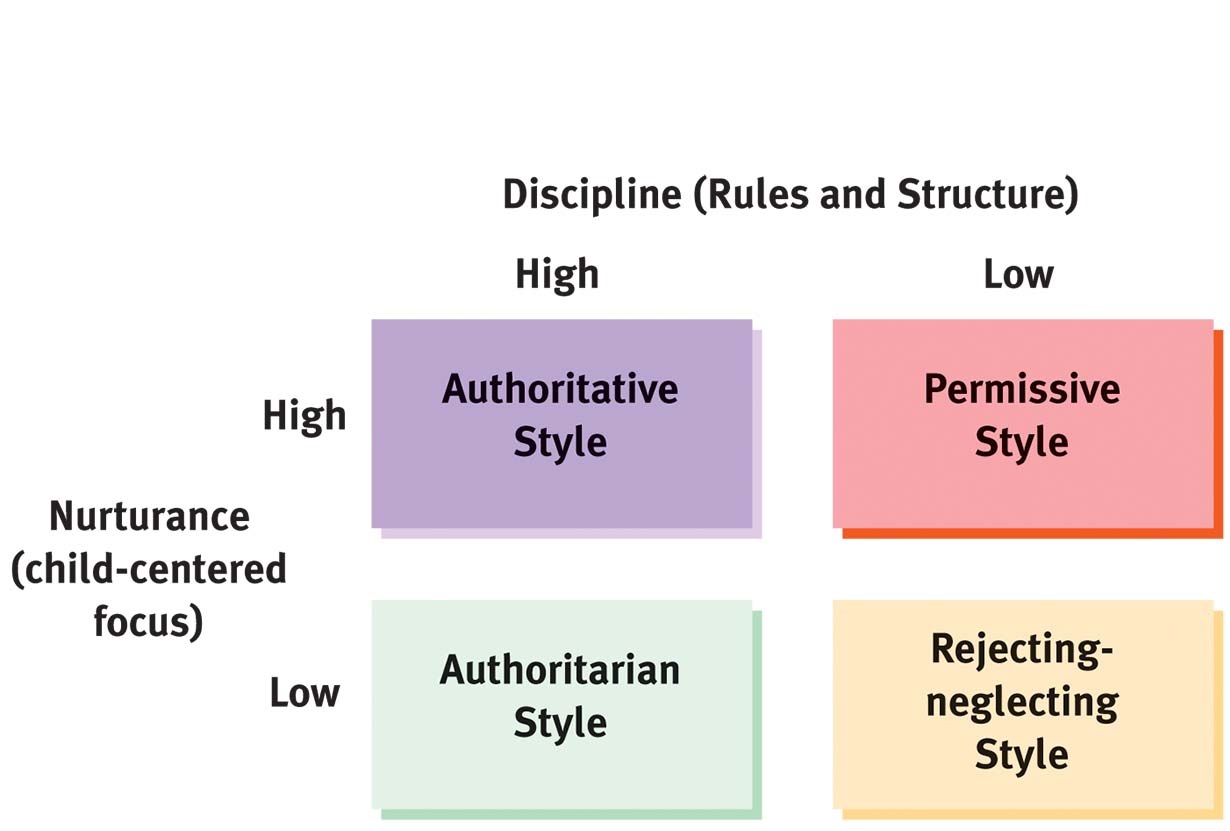Chapter 7. Settings for Development: Home and School
Introduction

In your book’s chapter on the settings (home and school) of development, you learned about the different parenting styles first identified by Diana Baumrind in the 1970s. The different parenting styles are classified based on how parents align on two dimensions of childrearing: nurturance and discipline. At first glance, these parenting styles seem to clearly define parenting practices.
Research has shown, however, that parenting styles can vary based on the child, situation, stage of development, and culture (Barnhart et al., 2013; Ferguson et al., 2013; Fuller & García Coll, 2010; Gau & Chang, 2013; Laukkanen et al., 2014; Mistry, Chaudhuri, & Diez, 2003; Pinquart, 2013; Schroeder & Mowen, 2014).
Activity
In this activity you will classify your primary caregiver along the dimensions of nurturance and discipline. After doing so, you may find problems with Baumrind’s parenting styles. Maybe you’ll find that your primary caregiver’s style varied from authoritative to permissive over time.
Answer the following questions yes or no. My primary caregiver…
1 of 16
H9XtQpdS+qbyaWMG0/hZwUVaRJisDX73x31ZqwDUk+gkA2KoQxiJ2Ew5CP9GsZGi6WmfCwDdsIh2abY1jAR5gX5PWAVVliZafgJL0ThgX0bip3GmaBIiDV4VlQU4kfOB6JtCV78iu49k/5N6rrUW3Q==2 of 16
15gvbUQ/Bj5P4gCg6Ru5TUvUF2SaRkbKi2Oi716kbBAKqjZ1PaBKY+5OGVAx1vKn9wd1eS+BjpwX7qfoP8FYOuOj5+Co9O/Ucjj4vl0fyxqUP0MvO1AFIub4NzOqS4pvaSU+yk54eOrfe1OYMyR3oFr2llYaKEAISqsvr2GKyxS8QAad3 of 16
ubct6E/d3S0WgJSpwS23NlnGiQbl0LYGTw3I67VEnlQZpGsHYGgc3QCgGHEWxgMd3t6KHRIggrVFCxSANzflhEXc94P5Ip1JFFtc+XOdoJDiaxcPWt/Alt8ZyfkAlNT2j/ztleAUfoHTpvvcqiRcdEK2QZC+eTHn4 of 16
Qd+Zk9grQmeLx1GV40RQmxJpT8lsiHO25Vyj5KcLm39oFMpyv28O/MthOFkMTS74e3L4yxPf+DAZFAzl07sORhOKtHPNxlJen2ivdpS2uiw5HuEMc3k3iZLVp+t/8+Pzv5JzV/ZsdFa+k76HyCUROErvYPVc3Gzrerfl+w==5 of 16
mIh4fmDmOa5HLfu2mvieQatI6LB27EbpN2Pysb9OwekOLZUtGi4SNUqvGlAQVWWtgLMl4MUP18kmAQiclKn6V2zrzO03HofdSK6Lry+Qx18kMqIqHQkOoNkDvZYMoB0GXSLSC4nruf14IhnSwho8wA==6 of 16
wXEUQ1QOLM6JiTU0PP8YcxIF7pDj71eH29DyspUjGXJcp4ATYZYSXY+nuLTsFkWtgUfQrBWqLG0sfK5r+/idiqkzPRDKQjegEm/cqn+0mRpF+gUQDzy67+MyuAczVeRHbMjVqKnokbpqbUy0trUiq4L+JeHLz1TEg2CrGuvfSwI=7 of 16
Yht2Fs1qDoyajN/AqDZ6mPfvsbmv2VlXRpQqL/RBBwuKEY1oBzg5D6AUkqClrCaS+6OdYcGsUvJ7I7zuADcamd9QgJ0LGYLO/N8OISAymxy51m+DMC2E5f4L5+OFWVtEMWJ0V72unHucrxC9FEnjPX+nyPbXwC76OQjMg9mSmVO//4mZvzpgxg==8 of 16
+ntmwB5sJtveF6GB1NYAtNiu41lf4KDV+ItX157E4t5OaH9bpYair/LB7tSB+mtSy+MYtxvIy8gAHBeQNsSAhzqsmu0NtLV3A8SCRe32KLqR+IRi2sdT+4K7VedWAap2E/xGlS38Qj3fBi4UUlKO6z2qL2EQZEe19 of 16
P3ezXwAqvHQleh8xURdb/vmMHkmixIjY7ezo6gxvBD3gS6Ny2T0xytfrS6K/viO4nMHdrWGS1VMLwv+9G860TPAm3IKFPSIZFbKwc4TKNx7fEWpkUT7a/gUiIjhoD3L1Ic2j9LNM64FHFZwcipO/JvIAkgG//jCKpaeyaRfyhFU=10 of 16
pjq1g6mdYDvz368DEpOe9Z+B9sqX9ZpLBN/Cizv2axpAYSv/kEHWWbAOrSZICiTjepYHwzo48Cud+JZSCO6vxIcbY96etd75A6Y59z7tejaBkPn6zbWqHlLFgXkdu70xLodbEA==11 of 16
iCymEw6gqqIXcvU6uK0AEwpVuDBCJWZvux23eXWw8OFlNuzFy/DGUncsran3XTXtz5ShMLt6S4tJ+u9n04t1+6/qrqnCz9Ai+38Ka6r2zJno68bjf/nDYhdliKi73pfeL9zBZIRrYqVpUd6S8wED1rBWQBJVUoTH80iwUqq/rXoLYcdlRgZfTGwPmxr586pcND2iEJ/tkAv2Vqx/rO68rQ==12 of 16
vpA+4BprocpXWtv1lfmQt58nzVibKgPqinU/I2EVWL3pT4uUAJSNC0wEXmFFfN+WJSU3G1Cs4O4rUTBYlZrOVk5GhuwwZfDKHAk05GeAFy5Wo3hW6FobklP2jjzeKLd8kYkOJcBUap7U1Y57+KRt2rrctK80Ck1y13 of 16
NztR7PP/RPADVLz06vTBWzYSWkHfeyPBUmc1RSmvWohNHvfqhU940AUz0NdZqnMjyFohgNRb6ADVKfMF9VPgQKiL7neAxm5auKzLEOPzmgLXPps7ypUrO6tR6hI=14 of 16
ZbitUj/9p2tsqDaEkeR44RvNiBSXX5dYuMXVKYlduXmy2cN7fpTN/nTug89hMXoUc88g/d/j/+pF5ODsKmNgz0oEEsIqjPdke1Uf05QQW4KoQ/ry5tCccHI9FLpzoDSdd0DbDLP6B9iLJe69ho78rqMhO/8=15 of 16
/lcGnk4k4yVAJmI19/ykkiHyXcjhXaqIlOEghAl61iabFdAVn46e9NnW2cqEv8FdQj0ZMaUPkP76MAW5wAfcIefyrvYYA5SytM1PUJ4bhkSj/8hZ7ZGLh10RXV99bLLMm/qHJKL6n/dWC9XpEuvYQw==16 of 16
Lt4RYwQBxkF9KXwRN2EJYOQFPruC3ezSkO+VLsi8xpLbF8a7avvU+JS12btcLr9K/j97+qYsDCiOQ0/RizLOx537PDtQ14himOpawEeq2pxl8IFhK5apGasWwjSrLz/jg37nnKA2cic=Something to Consider
1 of 1
xJGsV+5unhXP2LCYaIoO1A==Generally, there are four parenting styles:
- Authoritative parents: These parents are high in nurturance but also set rules for their children. They provide flexibility in how rules are implemented and enforced.
- Authoritarian parents: These parents enforce obedience and are often inflexible with the rules that they have set.
- Permissive parents: These parents are high in nurturance and give their child freedom. Rules are practically nonexistent.
- Rejecting-neglecting parents: These parents are low on both nurturance and structure. They often neglect, ignore, or emotionally abuse their children.
Overall, research has shown that the authoritative parenting style is best suited for child rearing (Maccoby & Martin, 1983). However, parenting styles do vary. As discussed previously, parenting varies based on the child, the situation, culture, and developmental stage (Barnhart et al., 2013; Ferguson et al., 2013; Fuller & García Coll, 2010; Gau & Chang, 2013; Laukkanen et al., 2014; Mistry, Chaudhuri, & Diez, 2003; Pinquart, 2013; Schroeder & Mowen, 2014).
Also, there are no firm guidelines about how to be an effective parent—except to show lots of love and provide consistent rules. And, some research has shown that parenting practices are not definitive in terms of overall development (Harris, 1995; 1998; 2002; 2006). It is important for parents to adapt their discipline to their unique child. Parents may face special challenges if they live in a dangerous environment or have a son or daughter who is “harder to raise.” Additionally, children cannot be massaged into having an idealized adult life. Your own future does not completely depend on how your parents raised you. Rather, you shape your own path in life!
If you decide to have children, what do you think your parenting style will be?
References
Baumrind, D. (1971). Current patterns of parental authority. Developmental Psychology, 4(1, Pt. 2), 1–103.
Barnhart, C., Raval, V., Jansari, A., & Raval, P. (2013). Perceptions of parenting style among college students in India and the United States. Journal of Child & Family Studies, 22(5), 684–693.
Ferguson, E. D., Hagaman, J. A., Maurer, S. B., Mathews, P., & Peng, K. (2013). Asian culture in transition: Is it related to reported parenting styles and transitivity of simple choices?, Journal of Applied Social Psychology, 43(4), 730-740.
Fuller, B., & García Coll, C. (2010). Learning from Latinos: Contexts, families, and child development in motion. Developmental Psychology, 46(3), 559–565.
Gau, S. S., & Chang, J. P. (2013). Maternal parenting styles and mother–child relationship among adolescents with and without persistent attention-deficit/hyperactivity disorder. Research in Developmental Disabilities, 34(5), 1581–1594.
Harris, J. R. (1995). Where is the child’s environment? A group socialization theory of development. Psychological Review, 102, 458–489.
Harris, J. R. (1998). The nurture assumption: Why children turn out the way they do. New York: Free Press.
Harris, J. R. (2002). Beyond the nurture assumption: Testing hypotheses about the child’s environment. In J. G. Borkowski, S. L. Ramey, & M. Bristol-Power (Eds.), Parenting and the child’s world: Influences on academic, intellectual, and social-emotional development (pp. 3–20). Mahwah, NJ: Erlbaum.
Harris, J. R. (2006). No two alike: Human nature and human individuality. New York: W. W. Norton & Co.
Laukkanen, J., Ojansuu, U., Tolvanen, A., Alatupa, S., & Aunola, K. (2014). Child’s difficult temperament and mothers’ parenting styles. Journal of Child and Family Studies, 23(2), 312–323.
Maccoby, E. E., & Martin, J. A. (1983). Socialization in the context of the family: Parent-child interaction. In P. H. Mussen (Series ed.) & E. M. Hethenington (Vol. ed.), Handbook of child psychology: Vol. 4. Socialization, personality, and social development (4th ed., pp. 1–101). New York: John Wiley & Sons.
Mistry, J., Chaudhuri, J., & Diez, V. (2003). Ethnotheories of parenting: Integrating culture and child development. In R. M. Lerner, F. H. Jacobs, & D. Wertlieb (Eds.), Handbook of applied developmental science: Promoting positive child, adolescent, and family development through research, policies, and programs (pp. 233–256). Thousand Oaks, CA: Sage.
Robinson, C., Mandleco, B., Olsen, S., & Hart, C. (1995). Authoritative, authoritarian, and permissive parenting practices: Development of a new measure. Psychological Reports, 77, 819-830.
Pinquart, M. (2013). Do the parent–child relationship and parenting behaviors differ between families with a child with and without chronic illness? A meta-analysis. Journal of Pediatric Psychology, 38(7), 708–721.
Schroeder, R. D., & Mowen, T. J. (2014). Parenting style transitions and delinquency. Youth & Society, 46(2), 228–254.